[English] 日本語
 Yorodumi
Yorodumi- PDB-1n86: Crystal structure of human D-dimer from cross-linked fibrin compl... -
+ Open data
Open data
- Basic information
Basic information
| Entry | Database: PDB / ID: 1n86 | |||||||||
|---|---|---|---|---|---|---|---|---|---|---|
| Title | Crystal structure of human D-dimer from cross-linked fibrin complexed with GPR and GHRPLDK peptide ligands. | |||||||||
 Components Components |
| |||||||||
 Keywords Keywords | BLOOD CLOTTING / cross-linked fibrin / protein-peptide complex | |||||||||
| Function / homology |  Function and homology information Function and homology informationblood coagulation, common pathway / induction of bacterial agglutination / fibrinogen complex / platelet alpha granule / Regulation of TLR by endogenous ligand / blood coagulation, fibrin clot formation / cellular response to leptin stimulus / MyD88 deficiency (TLR2/4) / positive regulation of heterotypic cell-cell adhesion / IRAK4 deficiency (TLR2/4) ...blood coagulation, common pathway / induction of bacterial agglutination / fibrinogen complex / platelet alpha granule / Regulation of TLR by endogenous ligand / blood coagulation, fibrin clot formation / cellular response to leptin stimulus / MyD88 deficiency (TLR2/4) / positive regulation of heterotypic cell-cell adhesion / IRAK4 deficiency (TLR2/4) / extracellular matrix structural constituent / MyD88:MAL(TIRAP) cascade initiated on plasma membrane / plasminogen activation / p130Cas linkage to MAPK signaling for integrins / positive regulation of peptide hormone secretion / positive regulation of vasoconstriction / GRB2:SOS provides linkage to MAPK signaling for Integrins / protein secretion / positive regulation of exocytosis / protein polymerization / cellular response to interleukin-1 / Integrin cell surface interactions / Common Pathway of Fibrin Clot Formation / negative regulation of endothelial cell apoptotic process / negative regulation of extrinsic apoptotic signaling pathway via death domain receptors / fibrinolysis / cell adhesion molecule binding / Integrin signaling / positive regulation of substrate adhesion-dependent cell spreading / platelet alpha granule lumen / cell-matrix adhesion / positive regulation of protein secretion / Post-translational protein phosphorylation / Signaling by high-kinase activity BRAF mutants / MAP2K and MAPK activation / response to calcium ion / platelet aggregation / Regulation of Insulin-like Growth Factor (IGF) transport and uptake by Insulin-like Growth Factor Binding Proteins (IGFBPs) / Signaling by RAF1 mutants / Signaling by moderate kinase activity BRAF mutants / Paradoxical activation of RAF signaling by kinase inactive BRAF / Signaling downstream of RAS mutants / Signaling by BRAF and RAF1 fusions / Platelet degranulation / extracellular vesicle / protein-folding chaperone binding / : / ER-Phagosome pathway / protein-containing complex assembly / cell cortex / protein-macromolecule adaptor activity / blood microparticle / adaptive immune response / positive regulation of ERK1 and ERK2 cascade / endoplasmic reticulum lumen / Amyloid fiber formation / signaling receptor binding / innate immune response / external side of plasma membrane / synapse / structural molecule activity / cell surface / endoplasmic reticulum / extracellular space / extracellular exosome / extracellular region / metal ion binding / plasma membrane Similarity search - Function | |||||||||
| Biological species |  Homo sapiens (human) Homo sapiens (human) | |||||||||
| Method |  X-RAY DIFFRACTION / X-RAY DIFFRACTION /  MOLECULAR REPLACEMENT / Resolution: 3.2 Å MOLECULAR REPLACEMENT / Resolution: 3.2 Å | |||||||||
 Authors Authors | Yang, Z. / Pandi, L. / Doolittle, R.F. | |||||||||
 Citation Citation |  Journal: Biochemistry / Year: 2002 Journal: Biochemistry / Year: 2002Title: The crystal structure of fragment double-D from cross-linked lamprey fibrin reveals isopeptide linkages across an unexpected D-D interface. Authors: Yang, Z. / Pandi, L. / Doolittle, R.F. #1:  Journal: Biochemistry / Year: 2002 Journal: Biochemistry / Year: 2002Title: Crystal structure of fragment D from lamprey fibrinogen complexed with the peptide Gly-His-Arg-Pro-amide. Authors: Yang, Z. / Spraggon, G. / Pandi, L. / Everse, S.J. / Riley, M. / Doolittle, R.F. #2:  Journal: Biochemistry / Year: 1998 Journal: Biochemistry / Year: 1998Title: Crystal structure of fragment double-D from human fibrin with two different bound ligands. Authors: Everse, S.J. / Spraggon, G. / Veerapandian, L. / Riley, M. / Doolittle, R.F. | |||||||||
| History |
|
- Structure visualization
Structure visualization
| Structure viewer | Molecule:  Molmil Molmil Jmol/JSmol Jmol/JSmol |
|---|
- Downloads & links
Downloads & links
- Download
Download
| PDBx/mmCIF format |  1n86.cif.gz 1n86.cif.gz | 287 KB | Display |  PDBx/mmCIF format PDBx/mmCIF format |
|---|---|---|---|---|
| PDB format |  pdb1n86.ent.gz pdb1n86.ent.gz | 229.9 KB | Display |  PDB format PDB format |
| PDBx/mmJSON format |  1n86.json.gz 1n86.json.gz | Tree view |  PDBx/mmJSON format PDBx/mmJSON format | |
| Others |  Other downloads Other downloads |
-Validation report
| Summary document |  1n86_validation.pdf.gz 1n86_validation.pdf.gz | 473.3 KB | Display |  wwPDB validaton report wwPDB validaton report |
|---|---|---|---|---|
| Full document |  1n86_full_validation.pdf.gz 1n86_full_validation.pdf.gz | 565.9 KB | Display | |
| Data in XML |  1n86_validation.xml.gz 1n86_validation.xml.gz | 41 KB | Display | |
| Data in CIF |  1n86_validation.cif.gz 1n86_validation.cif.gz | 59.1 KB | Display | |
| Arichive directory |  https://data.pdbj.org/pub/pdb/validation_reports/n8/1n86 https://data.pdbj.org/pub/pdb/validation_reports/n8/1n86 ftp://data.pdbj.org/pub/pdb/validation_reports/n8/1n86 ftp://data.pdbj.org/pub/pdb/validation_reports/n8/1n86 | HTTPS FTP |
-Related structure data
| Related structure data | 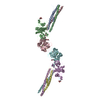 1n73C  1n8eC  1fzcS C: citing same article ( S: Starting model for refinement |
|---|---|
| Similar structure data |
- Links
Links
- Assembly
Assembly
| Deposited unit | 
| ||||||||
|---|---|---|---|---|---|---|---|---|---|
| 1 |
| ||||||||
| Unit cell |
|
- Components
Components
-Protein , 3 types, 6 molecules ADBECF
| #1: Protein | Mass: 10244.963 Da / Num. of mol.: 2 / Fragment: DOUBLE-D ALPHA CHAIN / Source method: isolated from a natural source / Details: fibrinogen from blood bank plasma / Source: (natural)  Homo sapiens (human) / References: UniProt: P02671 Homo sapiens (human) / References: UniProt: P02671#2: Protein | Mass: 37691.992 Da / Num. of mol.: 2 / Fragment: DOUBLE-D BETA CHAIN / Source method: isolated from a natural source / Details: fibrinogen from blood bank plasma / Source: (natural)  Homo sapiens (human) / References: UniProt: P02675 Homo sapiens (human) / References: UniProt: P02675#3: Protein | Mass: 36693.754 Da / Num. of mol.: 2 / Fragment: DOUBLE-D GAMMA CHAIN / Source method: isolated from a natural source / Details: fibrinogen from blood bank plasma / Source: (natural)  Homo sapiens (human) / References: GenBank: 6650830, UniProt: P02679*PLUS Homo sapiens (human) / References: GenBank: 6650830, UniProt: P02679*PLUS |
|---|
-Protein/peptide , 2 types, 4 molecules GHIJ
| #4: Protein/peptide | Mass: 329.376 Da / Num. of mol.: 2 / Fragment: sequence database residues 36-38 / Source method: obtained synthetically Details: synthetic peptide matching portion of human fibrin alpha chain References: UniProt: P02671 #5: Protein/peptide | Mass: 824.948 Da / Num. of mol.: 2 / Fragment: sequence database residues 45-51 / Source method: obtained synthetically Details: synthetic peptide matching portion of human fibrin beta chain References: UniProt: P02675 |
|---|
-Sugars , 2 types, 5 molecules 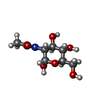
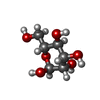

| #6: Sugar | ChemComp-NDG / #7: Sugar | ChemComp-MAN / | |
|---|
-Non-polymers , 1 types, 4 molecules 
| #8: Chemical | ChemComp-CA / |
|---|
-Details
| Has protein modification | Y |
|---|
-Experimental details
-Experiment
| Experiment | Method:  X-RAY DIFFRACTION / Number of used crystals: 1 X-RAY DIFFRACTION / Number of used crystals: 1 |
|---|
- Sample preparation
Sample preparation
| Crystal | Density Matthews: 2.96 Å3/Da / Density % sol: 58.42 % | |||||||||||||||||||||||||||||||||||||||||||||||||
|---|---|---|---|---|---|---|---|---|---|---|---|---|---|---|---|---|---|---|---|---|---|---|---|---|---|---|---|---|---|---|---|---|---|---|---|---|---|---|---|---|---|---|---|---|---|---|---|---|---|---|
| Crystal grow | Temperature: 295 K / Method: vapor diffusion, sitting drop / pH: 7.5 Details: PEG 3350, Tris buffer. 10 mM CaCl2, pH 7.5, VAPOR DIFFUSION, SITTING DROP, temperature 295K | |||||||||||||||||||||||||||||||||||||||||||||||||
| Crystal grow | *PLUS pH: 7 | |||||||||||||||||||||||||||||||||||||||||||||||||
| Components of the solutions | *PLUS
|
-Data collection
| Diffraction | Mean temperature: 100 K |
|---|---|
| Diffraction source | Source:  ROTATING ANODE / Type: RIGAKU / Wavelength: 1.54 Å ROTATING ANODE / Type: RIGAKU / Wavelength: 1.54 Å |
| Detector | Type: MARRESEARCH / Detector: IMAGE PLATE / Date: Sep 12, 2001 |
| Radiation | Monochromator: osmic mirrors / Protocol: SINGLE WAVELENGTH / Monochromatic (M) / Laue (L): M / Scattering type: x-ray |
| Radiation wavelength | Wavelength: 1.54 Å / Relative weight: 1 |
| Reflection | Resolution: 3.1→20 Å / Num. all: 38334 / Num. obs: 30589 / % possible obs: 79.8 % / Observed criterion σ(F): 0 / Observed criterion σ(I): 0 / Rmerge(I) obs: 0.131 |
| Reflection shell | Resolution: 3.1→3.17 Å / Rmerge(I) obs: 0.564 / % possible all: 49.4 |
| Reflection | *PLUS Num. measured all: 156847 |
| Reflection shell | *PLUS % possible obs: 50 % |
- Processing
Processing
| Software |
| |||||||||||||||||||||||||
|---|---|---|---|---|---|---|---|---|---|---|---|---|---|---|---|---|---|---|---|---|---|---|---|---|---|---|
| Refinement | Method to determine structure:  MOLECULAR REPLACEMENT MOLECULAR REPLACEMENTStarting model: fragment D from 1FZC Resolution: 3.2→20 Å / Cross valid method: THROUGHOUT / σ(F): 0 / σ(I): 0 / Stereochemistry target values: Engh & Huber
| |||||||||||||||||||||||||
| Refinement step | Cycle: LAST / Resolution: 3.2→20 Å
| |||||||||||||||||||||||||
| Refine LS restraints |
| |||||||||||||||||||||||||
| Refinement | *PLUS Lowest resolution: 20 Å / % reflection Rfree: 5 % | |||||||||||||||||||||||||
| Solvent computation | *PLUS | |||||||||||||||||||||||||
| Displacement parameters | *PLUS |
 Movie
Movie Controller
Controller


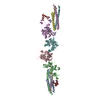
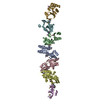


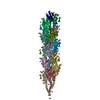
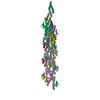

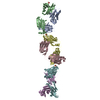
 PDBj
PDBj

















